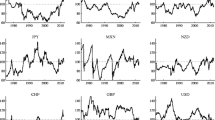Abstract
The ‘‘purchasing power parity puzzle’’ is the difficulty of reconciling very high short-term volatility of real exchange rates with very slow rates of mean reversion. The strongest evidence of slow mean reversion comes from least squares estimates of first-order autoregressive models of the long-horizon dollar-sterling real exchange rate. Using median-unbiased estimation methods, we show that these methods underestimate the half-lives of PPP deviations, and thus overestimate the speed of mean reversion. When the specification is amended to allow for serial correlation, the speed of mean reversion falls even further. This makes resolution of the purchasing power parity puzzle more problematic.
Similar content being viewed by others
Author information
Authors and Affiliations
Corresponding author
Additional information
First version received: May 2003/Final version received: July 2004
We thank Lutz Kilian, James Lothian, Mark Taylor, and two anonymous referees for helpful comments and suggestions.
Rights and permissions
About this article
Cite this article
Murray, C.J., Papell, D.H. The purchasing power parity puzzle is worse than you think. Empirical Economics 30, 783–790 (2005). https://doi.org/10.1007/s00181-005-0261-9
Issue Date:
DOI: https://doi.org/10.1007/s00181-005-0261-9




